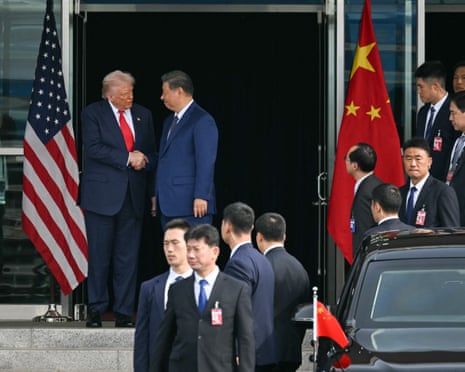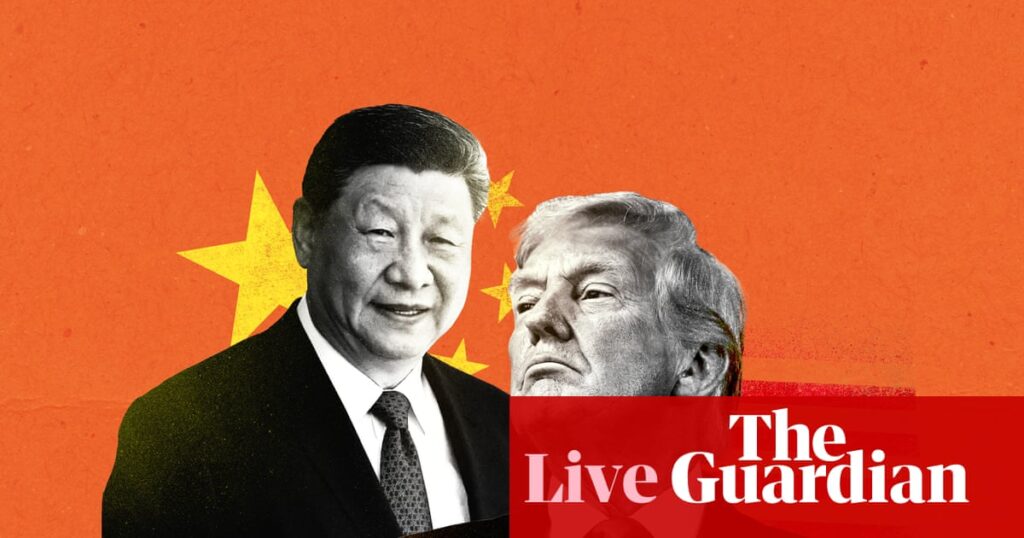Summary of the talks
In case you’re just joining us, here’s a rundown on what happened at the high-stakes talks between Donald Trump and Xi Jinping in South Korea.
Trump said afterwards that Washington’s dispute with Beijing over the supply of rare earths has been settled, China would resume buying US soybeans and Washington would reduce its tariffs on China.
Trump shook hands with Xi after their talks and boarded Air Force One to return to Washington, saying onboard that the meeting had been a “great success”.
He told reporters the Chinese leader had agreed to work “very hard” to prevent the production of the synthetic opioid fentanyl – blamed for many American deaths – and in exchange the US would reduce fentanyl-linked tariffs from 20% to 10%, lowering the overall tariff burden from 57% to 47%.
Trump also said he would visit China in April and that Xi would come to the US some time afterwards.
In key developments:
-
Xi said after the meeting that he and Trump had reached “consensus” on trade issues, Chinese state media reported. Xi said both sides should “finalise follow-up work as soon as possible, maintain and implement the consensus and provide tangible results to set minds at ease about the economies of China, the United States and the world”.
-
Trump said they had agreed to work together on Ukraine, adding that the war “came up very strongly” as an issue. “We talked about it for a long time, and we’re both going to work together to see if we can get something.”
-
Taiwan was not discussed at the meeting, Trump said. Earlier, both leaders ignored a question about the self-governing democracy, amid concern in Taipei that Trump may be willing to make concessions to Xi.
-
Before the meeting at Gimhae airbase in Busan, South Korea – their first face-to-face meeting in six years – Trump and Xi shook hands in front of their countries’ flags and the US president said: “We’re going to have a very successful meeting.” He added: “He’s tough negotiator – that’s not good,” before patting the Chinese leader on the back.

-
Trump had suggested before the meeting – at which their delegations faced each other across a negotiating table – that it could last three or four hours. The two leaders parted after one hour and 40 minutes.
-
Xi said China and the US should “stay on the right course” and “be partners and friends” and should “work together to accomplish more great and concrete things for the good of our two countries and the whole world”.
-
The optimism in Busan was in stark contrast to the recent exchanges of aggressive rhetoric over trade that had threatened to set the US and Chinese on an economic collision course, with potentially disastrous consequences globally. China’s yuan retreated from a near one-year high against the dollar on Thursday after the meeting met expectations but gave investors few new reasons for trade optimism.
-
Minutes before meeting Xi, Trump said in a social media post that he had ordered the Pentagon to start nuclear weapons testing at the same level of China and Russia. He did not respond to a reporter’s question about the decision as he and Xi began their summit.
With Justin McCurry and agencies
Key events

Lauren Almeida
Oil prices have fallen slightly as investors digest the new trade deal between Trump and Xi.
The two world leaders met in South Korea this morning, with Trump agreeing to reduce tariffs on China from 57% to 47% in a one-year deal, in exchange for Beijing resuming purchases of US soybeans, the continuation of rare earth exports and a crackdown on the trade of fentanyl.
Brent crude futures dropped by 0.31% to $64.72 a barrel this morning, while US West Texas Intermediate crude futures dropped by 0.33% to $60.28.
The drops suggest that some investors are sceptical that the new agreement marks an end to the trade war. But president Trump has said his discussions with Xi were “fantastic”, and emphasised their “great relationship”.
You can follow more market reaction to the meeting in our business live blog:
Earlier we reported that Donald Trump said he would visit China next year.
A Chinese foreign ministry spokesperson has now confirmed that, saying the trip has been scheduled for April.
Summary of the talks
In case you’re just joining us, here’s a rundown on what happened at the high-stakes talks between Donald Trump and Xi Jinping in South Korea.
Trump said afterwards that Washington’s dispute with Beijing over the supply of rare earths has been settled, China would resume buying US soybeans and Washington would reduce its tariffs on China.
Trump shook hands with Xi after their talks and boarded Air Force One to return to Washington, saying onboard that the meeting had been a “great success”.
He told reporters the Chinese leader had agreed to work “very hard” to prevent the production of the synthetic opioid fentanyl – blamed for many American deaths – and in exchange the US would reduce fentanyl-linked tariffs from 20% to 10%, lowering the overall tariff burden from 57% to 47%.
Trump also said he would visit China in April and that Xi would come to the US some time afterwards.
In key developments:
-
Xi said after the meeting that he and Trump had reached “consensus” on trade issues, Chinese state media reported. Xi said both sides should “finalise follow-up work as soon as possible, maintain and implement the consensus and provide tangible results to set minds at ease about the economies of China, the United States and the world”.
-
Trump said they had agreed to work together on Ukraine, adding that the war “came up very strongly” as an issue. “We talked about it for a long time, and we’re both going to work together to see if we can get something.”
-
Taiwan was not discussed at the meeting, Trump said. Earlier, both leaders ignored a question about the self-governing democracy, amid concern in Taipei that Trump may be willing to make concessions to Xi.
-
Before the meeting at Gimhae airbase in Busan, South Korea – their first face-to-face meeting in six years – Trump and Xi shook hands in front of their countries’ flags and the US president said: “We’re going to have a very successful meeting.” He added: “He’s tough negotiator – that’s not good,” before patting the Chinese leader on the back.
-
Trump had suggested before the meeting – at which their delegations faced each other across a negotiating table – that it could last three or four hours. The two leaders parted after one hour and 40 minutes.
-
Xi said China and the US should “stay on the right course” and “be partners and friends” and should “work together to accomplish more great and concrete things for the good of our two countries and the whole world”.
-
The optimism in Busan was in stark contrast to the recent exchanges of aggressive rhetoric over trade that had threatened to set the US and Chinese on an economic collision course, with potentially disastrous consequences globally. China’s yuan retreated from a near one-year high against the dollar on Thursday after the meeting met expectations but gave investors few new reasons for trade optimism.
-
Minutes before meeting Xi, Trump said in a social media post that he had ordered the Pentagon to start nuclear weapons testing at the same level of China and Russia. He did not respond to a reporter’s question about the decision as he and Xi began their summit.
With Justin McCurry and agencies

Helen Davidson
On his Truth Social account before the meeting, Trump had described the Busan catch-up as the “G2”, a nod to the US and China being the world’s biggest economies and a play on the names of other formal multilateral groupings like the G7 and G20.
Even though it’s not an official name, “G2” has been welcomed by some Chinese people online.
“Clearly, the core of the global order is the US-China relationship”, said one popular post on Weibo.
Another said:
Americans’ attitudes are shifting quickly; they are gradually adapting to the idea that the US and China are starting to stand on equal footing, and the world is big enough to accommodate a G2.
With Lillian Yang
Xi says ‘consensus’ reached with Trump on trade – reports
Chinese state media is reporting that Xi Jinping says “consensus” was reached with Trump on trade issues.
It also said after the leaders’ meeting that they agreed to strengthen cooperation in energy and trade.
They also agreed to maintain communications, news agencies cited state media as saying.
China’s Xinhua agency quoted Xi as saying:
The economic and trade teams of the two countries exchanged in-depth views on important economic and trade issues and reached a consensus on resolving them.
Both teams should refine and finalise follow-up work as soon as possible, maintain and implement the consensus and provide tangible results to set minds at ease about the economies of China, the United States and the world.
More now on rare earths: Donald Trump has said his meeting with Xi Jinping removed the “roadblock” on the crucial minerals, yielding a one-year extendable deal on rare earth supplies.
China exercises a virtual monopoly on so-called “rare earth” metals, essential for everything from household appliances to cars, energy and weapons.
“All the rare earths has been settled, and that’s for the world,” Trump was reported as saying after the meeting, adding that the deal was for a year and would be re-negotiated annually.
During his Asia tour, Trump also signed a deal with Japan securing supplies of critical minerals and rare earths.
The US president said:
There’s no roadblock at all on rare earths – that will hopefully disappear from our vocabulary for a little while.
And for a quick brush-up on the crucial minerals – which are critical for defence, auto and electronic industries and have become a flashpoint in international diplomacy and trade – we have this explainer:
Five key takeaways from Trump-Xi meeting

Helen Davidson
Trump has just given a press conference on a very bumpy Air Force One. He’s gone into quite a bit of detail about the meeting’s outcomes, saying it was a 12 out of 10. Trump said the meeting was “amazing”, with “an outstanding group of decisions made”.
“We’ve come to a conclusion on many important points,” he said.
Noting that we do not yet have anything from the Chinese side on their interpretation of events, here are some key takeaways from what Trump has said:
Visits
The US president told reporters he would go to China in April and that Xi “will be coming here some time after that. Whether it’s in Florida, Palm Beach or Washington DC”.
Rare earths
Trump said China has agreed on a one-year deal to supply rare earths, after its shock announcement that it was banning exports if there was any chance of the products having dual use for foreign militaries or some semiconductor sectors. But Trump said Xi said “they’re gonna keep those flowing”. He expected the one-year deal to be extended.
Trump said:
All of the rare earth has been settled. That roadblock is gone now, there’s no roadblock at all on rare earths.
Tariffs
Trump said Xi was going to “work very hard to stop the flow” of precursor chemicals that the US said are being used to make fentanyl. The US had put a 20% tariff on Chinese products specifically to pressure Beijing over fentanyl. Today Trump says he’s reduced it to 10%, lowering the overall tariff burden from 57% to 47%.
Chips
Trump said he and Xi discussed China buying chips from Nvidia, but that US was more of an “arbitrator or referee” between them. When asked if he was going to allow Nvidia’s new Blackwell AI chip to be sold to China, Trump said: “We’re not talking about the Blackwell … But a lot of chips, you know, a lot of the chips. And that’s good for us”.
Ukraine and Taiwan
The war in Ukraine, sparked by Russia’s 2022 invasion, “did come up”, Trump said, saying the US and China are going to work together on it to stop people being killed.
However, he also said:
The two sides are locked in fighting, and sometimes you’ve got to let them fight I guess. Crazy.
Taiwan, which China is threatening to annex militarily, “never came up”, Trump said on Air Force One. “That was not discussed actually.”
One topic that was not discussed in his talks with Xi was Taiwan, Trump said.
Earlier, both leaders ignored a question about the self-governing democracy, amid concern in Taipei that Trump may be willing to make concessions to Xi, who has vowed to “reunify” it with the mainland.
Trump says China to resume buying US soybeans and keep exporting rare earths
Donald Trump has said a deal he struck to reduce tariffs on China involves Beijing in return resuming US soybean purchases, keeping rare earths exports flowing and cracking down on the illicit trade of fentanyl.
Trump also said after his meeting with Xi Jinping that it had been a “great success” and and he would visit China in April for new talks.
The US president repeatedly talked up the prospect of reaching an agreement with Xi since US negotiators on Sunday said they had agreed on a framework with China that would avoid 100% US tariffs on Chinese goods and achieve a deferral of China’s export curbs on rare earths, a sector it dominates.
Chinese stocks climbed to a decade high and the yuan currency to a near one-year peak against the dollar as investors hoped for an easing of trade tensions that have upended supply chains and rocked global business confidence.
Trump told reporters aboard Air Force One about the leaders’ coming visits:
I’ll be going to China in April and he’ll be coming here sometime after that, whether it’s in Florida, Palm Beach or Washington DC.
“A lot of things we brought to finalisation” at Thursday’s talks in Busan, Trump added.
With agencies

Helen Davidson
Continued from last post:
Like today with Nvidia’s AI chips, there were also issues around tech and security. In 2019, US companies were banned from selling products to Chinese tech giant Huawei, on national security grounds. Trump said the issue was “mentioned” but deferred proper discussion about lifting the ban.
Trump and Xi didn’t talk directly about Huawei executive Meng Wanzhou, who was at the time detained in Canada on a US arrest warrant. Two Canadians – Michael Kovrig and Michael Spavor – were simultaneously being detained in China, in what was widely seen as an act of hostage diplomacy. All three were later released in an apparent deal, more than two years later.
There’s not yet been full details of how today’s meeting went, but Chinese state media reported earlier: “During the meeting, Trump said that the US and China have reached many consensus and will reach even more, saying: ‘I believe we will build a long-term, good relationship’.”

Helen Davidson
The last time Xi and Trump met was in June 2019, during Trump’s first term. Looking back at it feels … familiar.
The meeting was in Osaka, on the sidelines of the G20, and just months after trade talks (during the first Trump-China trade war) had broken down. The US had accused China of reneging on trade promises, and Trump raised tariffs from 10% to 20% on about $200bn of Chinese imports. China had hit back with its own tariffs.
Today, a mishmash of overlapping industry and punishment specific tariffs are on average far higher, and the US is threatening 100% tariffs if China doesn’t back down from its ban on some rare earth sales.
But in 2019 the meeting appeared to help, with Trump declaring things to be “right back on track”. He praised Xi as a great leader, and Xi noted there had been disagreements but that it was important the relationship remain strong.
Both sides said they would not impose further tariffs and that the world’s two biggest economies would restart negotiations on a trade deal. He said China would soon be buying “a tremendous amount of food and agricultural product”, again in parallel with today’s meeting as Trump sought to have China restart its US soybean purchases.
Continued next post
Donald Trump also said aboard Air Force One after the meeting that the US and China would “work together” on the Ukraine war.
Trump says rare earths issue settled
Trump also said the rare earths issue has been settled and there would be no more roadblocks on them.
Speaking aboard Air Force One, the US president was also reported as saying it was a one-year agreement that would be extended.
Trump also said US tariffs on China would be lowered to 47% from 57%.
He said he would be going to China in April and that Xi would come to the US at some stage after that, in comments carried by Reuters.
He also said Taiwan didn’t come up during the meeting.
Donald Trump has been reported as saying that his meeting with Xi Jinping today was amazing and it was agreed that the Chinese leader would work very hard to stop fentanyl.
Trump hinted this week he would reduce US tariffs on Chinese goods in exchange for a commitment by Beijing to stem the flow of ingredients needed to make fentanyl, an opioid that is the leading cause of overdose deaths in the US.
We’ll bring you more comments from Trump as they come in.

